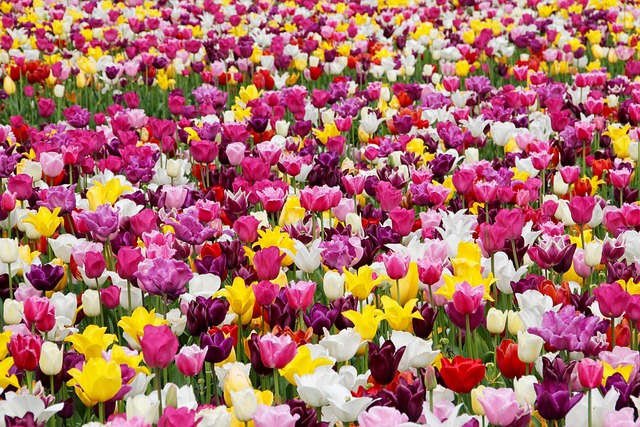Vertical gardens are innovative horticultural systems that offer sustainable and space-efficient solutions for integrating greenery into urban environments. These wall-based gardens enhance city aesthetics, serve as green spaces amidst land scarcity, improve air quality, provide natural cooling, and counteract urban heat islands in densely populated areas. They extend growing seasons, accommodate a wide range of plants within limited spaces, often paired with smart irrigation systems to conserve water. Vertical gardens are more than aesthetic choices; they're crucial for promoting biodiversity by supporting habitats for beneficial insects and birds, aiding in pollination and pest control without chemicals. They also enable urban agriculture, allowing residents to cultivate their own food, contributing to local food security. The success of these gardens depends on expert installation, careful site assessment for sunlight exposure and water availability, strategic plant selection, and adherence to sustainable practices. Maintenance involves regular watering with efficient systems like drip irrigation, seasonal fertilization, pest and disease monitoring, and cleaning to maintain sunlight access. The longevity and effectiveness of a vertical garden rely on this holistic approach, making it a resilient feature in urban design that fosters our connection with nature. Keywords: vertical garden, sustainable, urban horticulture, green space, biodiversity, urban agriculture, smart irrigation, air quality, urban heat island, wall garden.
Embark on a greener path with expert vertical garden installation, an innovative approach to maximizing urban spaces. This article delves into the transformative power of wall gardens, exploring their myriad benefits for modern cities. From enhancing air quality and providing local food sources to creating serene green oases in cramped settings, these vertical wonders offer a multitude of advantages. We’ll guide you through site assessment and preparation, ensuring your space is primed for optimal garden installation. Next, we’ll help you navigate the diverse range of wall garden structures, identifying the best system for your unique needs. Mastery over the installation process awaits with our detailed step-by-step techniques, setting the stage for a lush and vibrant vertical garden. Finally, learn the ins and outs of maintenance to keep your green creation flourishing throughout the year. Embrace the revolution in urban gardening and reap the myriad benefits of incorporating a vertical garden into your home or business.
- Understanding the Vertical Garden Revolution: The Benefits of Wall Gardens for Urban Spaces
- Site Assessment and Preparation: Essential Steps for Optimal Vertical Garden Installation
- Selecting the Right System: A Guide to Different Types of Wall Garden Structures
- Mastering the Installation Process: Step-by-Step Techniques for a Successful Vertical Garden
- Maintenance and Care: Ensuring Your Wall Garden Thrives Through the Seasons
Understanding the Vertical Garden Revolution: The Benefits of Wall Gardens for Urban Spaces

Vertical gardens represent a transformative approach in modern horticulture, offering a sustainable and space-efficient solution for urban environments. These innovative wall gardens not only enhance the aesthetic appeal of otherwise barren walls but also serve as vital green spaces in densely populated cities where land for traditional gardening is scarce. They contribute to creating healthier living conditions by improving air quality, providing natural cooling, and offering an oasis of greenery that can mitigate the effects of urban heat islands. Additionally, wall gardens extend the growing season vertically, allowing for a greater diversity of plants and crops in limited spaces, and can be integrated with smart irrigation systems to conserve water, making them an eco-friendly option for both residential and commercial properties.
The integration of vertical gardens into urban architecture is more than a design element; it’s a response to the pressing environmental challenges of our time. These wall garden systems promote biodiversity by providing habitats for beneficial insects and birds, which in turn can support pollination and pest control naturally. Moreover, they offer a platform for urban agriculture, enabling city dwellers to grow their own food and contribute to local food security. Expert installation is crucial to ensure the longevity and functionality of these systems, as it involves careful selection of plants, optimal placement, and integration with sustainable practices. As cities continue to expand, vertical gardens stand out as a resilient solution for maintaining our connection with nature in the heart of urban life.
Site Assessment and Preparation: Essential Steps for Optimal Vertical Garden Installation

When planning for a vertical garden installation, a comprehensive site assessment is paramount to ensure the garden’s success and sustainability. The choice of location should consider factors such as sunlight exposure, water access, and structural integrity of the support wall. Conducting an analysis of these elements will help determine the most suitable types of plants and their arrangement within the wall garden, optimizing for growth and aesthetics. Additionally, assessing local climate conditions, including temperature and humidity levels, is crucial to select plant species that thrive in the given environment. This meticulous evaluation and preparation lay the groundwork for a flourishing vertical garden, which can enhance urban spaces, provide fresh produce, or create a living art piece.
Upon selecting an optimal site, proper preparation is essential to support the structure and growth of your vertical garden. This involves ensuring the wall’s stability and durability through necessary repairs or reinforcements. The installation should include a robust support system designed to distribute the weight evenly across the structure. Furthermore, the integration of a reliable watering system tailored to the garden’s design is essential for consistent plant hydration. Proper drainage mechanisms must also be in place to prevent waterlogging and ensure the health and longevity of your vertical garden on the wall. Attention to these details during the site assessment and preparation phase can mitigate potential issues, leading to a resilient and productive vertical garden installation.
Selecting the Right System: A Guide to Different Types of Wall Garden Structures

When embarking on the creation of a vertical garden, selecting the appropriate system is paramount to its success. The structure chosen will influence everything from maintenance requirements to the types of plants that can be grown. Wall gardens come in various configurations and materials, ranging from simple shelving units to complex hydroponic systems. For those with limited space but a desire for greenery, slat-based designs are an excellent option; they allow for versatile planting arrangements without the need for extensive installation. Additionally, considering the weight and watering needs of your chosen plants is crucial when selecting the material and design of your vertical garden structure. Options like PVC, metal, or timber each offer different advantages in terms of longevity, durability, and aesthetic appeal.
Another key factor in vertical garden selection is the specific environment where it will be installed. Climate conditions can greatly affect both the health of the plants and the lifespan of the structure. For instance, in areas with high humidity or salt spray, corrosion-resistant materials are essential. Conversely, in regions with extreme temperatures, insulated panels might be necessary to protect sensitive plant species. Furthermore, the orientation of the garden on the wall should be considered; south-facing walls tend to receive more sunlight, which is ideal for photosynthesis and can influence the types of plants that thrive in your vertical ecosystem.
Mastering the Installation Process: Step-by-Step Techniques for a Successful Vertical Garden

Embarking on a vertical garden installation offers a space-efficient and aesthetically pleasing way to cultivate greenery in limited areas. A well-designed wall garden not only enhances the visual appeal of any space but also provides a sustainable solution for growing plants. To achieve a successful vertical garden, careful planning and precise execution are key. Begin by selecting an appropriate wall with adequate sunlight, ensuring that the structure can support the weight of the plants and irrigation system. Next, choose high-quality trellises or supports that align with the specific growth patterns of your chosen plants. These structures should be securely anchored to prevent tilting or shifting over time. Once the supports are in place, install a robust irrigation system designed for vertical gardens to deliver water and nutrients directly to each plant, optimizing growth and conserving water. The use of drip irrigation is highly recommended due to its efficiency and precision in delivering water where it’s needed most. With the supports and irrigation system set up, select a diverse array of plants that thrive in vertical gardens, considering factors like light exposure, soil type, and space requirements. Ensure that each plant is properly spaced to allow for adequate air circulation and growth, contributing to the overall health and vitality of your vertical garden. Through meticulous preparation and attention to detail, you can transform a bare wall into a lush, thriving vertical garden that complements its surroundings and brings life to any space.
Maintenance and Care: Ensuring Your Wall Garden Thrives Through the Seasons

Maintaining a vertical garden, particularly a wall garden, involves a series of careful practices tailored to seasonal changes to ensure its lush vitality throughout the year. Regular watering is paramount, as the frequency and amount needed can fluctuate with temperature and humidity levels; installing a drip irrigation system can provide consistent hydration while conserving water. Monitoring soil moisture with a moisture meter helps prevent over or under-watering, which can be detrimental to plant health. Additionally, seasonal adjustments in fertilization are crucial. During the growing season, a balanced, slow-release fertilizer promotes healthy growth, while in cooler months, a reduced frequency ensures plants aren’t overwhelmed during their dormancy. Regular inspections for pests and diseases should be part of your maintenance routine, as early detection can minimize impact and preserve the beauty and functionality of your wall garden.
The orientation and material of your wall garden will influence its exposure to sunlight, a key factor in plant selection and growth patterns. South-facing walls typically receive the most light, making them ideal for sun-loving species. North-facing walls may require shade-tolerant plants or strategic placement of reflective materials to maximize light exposure. Regularly cleaning the garden’s surface ensures that light reaches your plants effectively and that any algae or dirt buildup doesn’t hinder their development. Pruning and training plants to desired shapes not only maintains aesthetics but also promotes air circulation and sunlight penetration, which are essential for a thriving vertical garden.
Vertical gardens represent a green evolution in urban landscapes, offering both aesthetic appeal and functional benefits. With careful site assessment, thoughtful selection of systems, and dedicated maintenance, these living walls can become a flourishing addition to any space. By embracing the insights provided on understanding the revolution, selecting the right system, mastering installation techniques, and maintaining your garden, you’re well-equipped to transform barren walls into vibrant, productive vertical gardens. These green structures not only enhance the visual appeal of urban environments but also contribute to environmental sustainability. As cities continue to grow, the role of vertical gardens in our lives is set to expand, making them a valuable component for modern living spaces.
